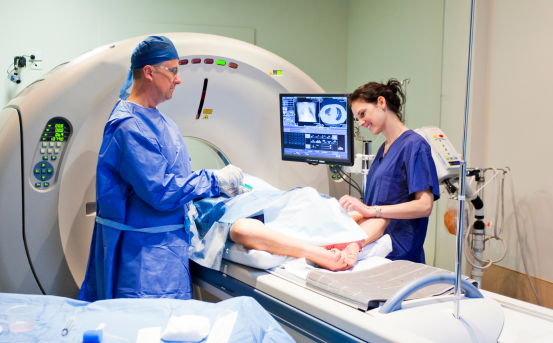Types of Radiation oncology is a crucial branch of cancer treatment, focusing on the use of targeted radiation to destroy cancer cells while sparing healthy tissues. While it is commonly associated with non-invasive therapies like external beam radiation, it also encompasses certain surgical procedures that incorporate radiation either before, during, or after the operation. Understanding the types of radiation oncology surgery is essential for patients navigating their cancer treatment options.
While radiation therapy is often associated with non-invasive treatments like External Beam Radiation Therapy (EBRT) or proton therapy, its role extends far beyond standalone approaches. In many cancer care plans, radiation is integrated with surgical procedures to enhance treatment outcomes. These combinations may involve delivering radiation before surgery to shrink the tumor (neoadjuvant therapy), during surgery through targeted methods like Intraoperative Radiation Therapy (IORT), or after surgery to eliminate any remaining cancer cells (adjuvant therapy).
What Is Radiation Oncology Surgery?
Radiation oncology surgery refers to a combination of surgical and radiation therapy techniques to treat cancer more effectively. While traditional surgery physically removes tumors, radiation therapy uses high-energy beams to damage cancer cell DNA, leading to cell death or impaired replication. In some cases, these two methods are integrated to improve outcomes.
There are three major ways radiation is used in conjunction with surgery:
-
Preoperative (neoadjuvant) radiation :- to shrink the tumor before surgery.
-
Intraoperative radiation therapy (IORT) :- administered during surgery directly to the tumor bed.
-
Postoperative (adjuvant) radiation :- used after surgery to eliminate residual cancer cells.
Each approach has specific indications depending on the type, location, and stage of cancer.
External Beam Radiation Therapy (EBRT) With Surgery
Overview :-
External beam radiation therapy is the most widely used form of radiation treatment. It involves directing high-energy rays from a machine outside the body to the cancer site.
Surgical Integration :-
-
Before Surgery :- EBRT may be used to reduce tumor size, making surgical removal easier and less invasive.
-
After Surgery :- It is commonly used to target areas where microscopic cancer cells might remain, reducing recurrence risk.
Cancers Treated :-
-
Breast cancer
-
Rectal cancer
-
Brain tumors
-
Head and neck cancers
-
Prostate cancer
Benefits :-
-
Non-invasive
-
Can be precisely targeted
-
Works synergistically with surgery
Intraoperative Radiation Therapy (IORT)
Overview :-
IORT involves delivering a concentrated dose of radiation to a tumor site immediately after the tumor is surgically removed. This occurs during the operation, in a controlled, sterile environment.
How It Works :-
-
After tumor removal, a specialized applicator delivers radiation directly to the area where the tumor was located.
-
Healthy surrounding tissues are temporarily moved aside or shielded to prevent radiation damage.
Cancers Treated :-
-
Breast cancer
-
Colorectal cancer
-
Pancreatic cancer
-
Gynecologic cancers
-
Soft tissue sarcomas
Benefits :-
-
Direct, high-dose radiation reduces local recurrence
-
Protects healthy tissue more effectively than external radiation
-
Often shortens the overall radiation treatment time
Limitations :-
-
Requires access to advanced technology and trained surgical-radiation teams
-
Not suitable for all tumor types or stages
Brachytherapy (Internal Radiation) with Surgery
Overview :-
Brachytherapy involves placing radioactive material directly inside or next to the tumor. It may be temporary or permanent, and it’s often used alongside surgical procedures.
Surgical Application :-
-
Often used postoperatively to deliver high radiation doses directly to the tumor bed.
-
In some cancers, it is implanted during surgery and left in place (e.g., prostate seed implants).
Cancers Treated :-
-
Prostate cancer
-
Cervical cancer
-
Endometrial cancer
-
Head and neck cancers
-
Esophageal cancer
Benefits :-
-
Minimizes radiation exposure to surrounding healthy tissues
-
Delivers high-dose radiation in fewer sessions
-
Effective in hard-to-reach areas
Types of Brachytherapy :-
-
High-dose rate (HDR) :- Short bursts of intense radiation for a few minutes
-
Low-dose rate (LDR) :- Continuous, low-intensity radiation over several days or weeks
-
Permanent seed implants :- Radioactive seeds are left permanently in the body
Stereotactic Radiosurgery (SRS)
Overview :-
Despite the name, stereotactic radiosurgery is not a traditional surgery. It’s a non-invasive procedure that uses precisely focused beams of radiation to treat tumors in a single session.
Surgical Relevance :-
-
Often used as an alternative to open brain surgery
-
Also used postoperatively when removing tumors is risky or incomplete
Cancers Treated :-
-
Brain metastases
-
Acoustic neuromas
-
Pituitary tumors
-
Spine tumors
-
Certain lung or liver cancers (via SBRT)
Benefits :-
-
Outpatient procedure
-
No incision, minimal recovery time
-
Precise radiation limits side effects
Cytoreductive Surgery with HIPEC and Radiation
Overview :-
In advanced abdominal cancers, cytoreductive surgery removes visible tumors, followed by HIPEC (Hyperthermic Intraperitoneal Chemotherapy). In select cases, radiation is added pre- or post-operatively to improve outcomes.
Cancers Treated :-
-
Ovarian cancer
-
Colorectal cancer with peritoneal spread
-
Pseudomyxoma peritonei
Radiation Role :-
-
Pre-surgical radiation helps shrink tumor spread
-
Postoperative radiation may target areas inaccessible during surgery
Benefits :-
-
Combines the power of surgery, heat-enhanced chemotherapy, and radiation
-
Potentially curative in select advanced-stage cancers
Choosing the Right Radiation Oncology Surgery
Selecting the appropriate type of radiation oncology surgery depends on several factors :-
-
Type and stage of cancer
-
Tumor location and size
-
Overall health and age of the patient
-
Previous treatments received
-
Availability of technology and expertise
Your oncologist, surgeon, and radiation specialist will collaborate to tailor the best treatment plan for you.
Risks and Side Effects of Radiation-Related Surgeries
While radiation oncology surgeries are generally safe and effective, they can carry some risks :-
-
Delayed wound healing due to radiation
-
Tissue fibrosis or scarring
-
Fatigue
-
Infection (surgical risk)
-
Skin irritation (with external beam therapy)
-
Rare long-term complications like secondary cancers
Close follow-up and a multidisciplinary care team can help minimize these risks.
Latest Advances in Radiation Oncology Surgery
Technology is continually evolving in the field of radiation oncology. Some exciting developments include :-
-
Image-guided radiation therapy (IGRT) for more precise targeting
-
Proton therapy, offering minimal collateral damage to surrounding tissues
-
Robotic-assisted surgeries combined with radiation for better precision
-
Adaptive radiation therapy, adjusting treatment in real-time based on tumor response
These advancements offer hope for better outcomes, fewer side effects, and improved quality of life.
Conclusion
Radiation oncology surgery is a powerful component of modern cancer treatment. From intraoperative radiation therapy (IORT) to brachytherapy and stereotactic radiosurgery, each method plays a vital role in improving cancer control and survival rates.
As medical technologies continue to evolve, radiation-based surgical techniques are becoming more advanced, less invasive, and more personalized. Innovations like image-guided radiation, proton therapy, and adaptive radiation planning ensure that treatment is increasingly accurate, reducing damage to healthy tissues while maximizing impact on cancer cells.























